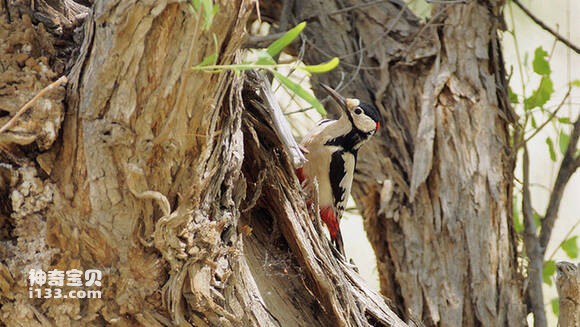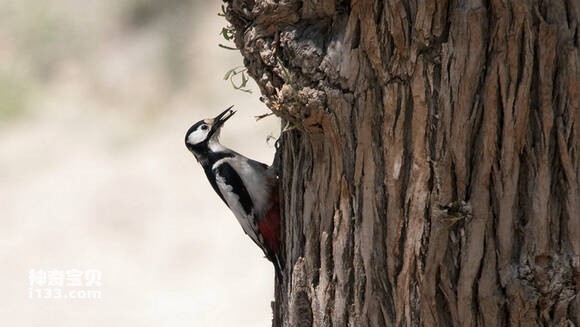Dendrocopos leucopterus
IUCN
LCBasic Information
Scientific classification
- name:Dendrocopos leucopterus
- Scientific Name:Dendrocopos leucopterus,White-winged Woodpecker
- Outline:Climbing birds
- Family:Picipitidae Picidae Woodpecker
Vital signs
- length:22-23cm
- Weight:40-60g
- lifetime:20-30years
Feature
It looks very similar to the Great Spotted Woodpecker, but has white wings.
Distribution and Habitat
In China, the white-winged woodpecker is distributed in Karamay in northern Xinjiang, the western Tianshan Mountains and the southern region. Outside China, it is distributed in Afghanistan, Kazakhstan, Kyrgyzstan, Tajikistan, Turkmenistan and Uzbekistan.
The white-winged woodpecker mainly inhabits broad-leaved forests and secondary forests in low mountains, hills, foothills, plains, lowlands, valleys, rivers and other places below 2,000 meters above sea level. It also appears in poplar and birch forests, willow forests, shrubs, hillside grasslands, orchards and parks, and even in sparse shrub areas in semi-desert areas. It rarely appears in coniferous forests.
Appearance
The male white-winged woodpecker has white forehead, ear coverts and underparts, rose-red abdomen and undertail coverts; the top of the head, back are black, and there is a red patch on the nape. A wide black band starts from the corner of the mouth and extends backward and downward to the chest. The upper wing coverts, shoulders and inner flight feathers are white, and the inner flight feathers have black central stripes and tips; the primary flight feathers are mainly white with black subterminal spots and tips. The 4 pairs of central tail feathers are black, and the two pairs of outer tail feathers are white with black horizontal stripes. The female white-winged woodpecker is similar to the male, but there is no red patch on the nape. Juveniles are similar to adults, but the white area on the flight feathers and tail is larger, and the red spot on the head is not on the nape but on the top of the head.
Size measurement: body length 220-230 mm, wing length male 124-131 mm, female
Details
White-winged Woodpecker is a small bird with no subspecies.

White-winged Woodpecker is a resident bird, often acting alone, and in pairs during the breeding season. It mainly feeds on various insects such as longhorn beetle adults and larvae, coleoptera insects, click beetles, ants, bark beetles, jewel beetles, aphids, pine caterpillars and insect eggs. It also eats other small invertebrates such as spiders and worms. In autumn and winter, it also eats some fruits and seeds of plants such as acorns, pine nuts and blackberry.

The breeding season of the white-winged woodpecker is from March to May, and it nests in tree holes. It usually pecks a new hole every year. Sometimes it pecks out a hole and then abandons it, and then pecks a new hole again. Generally, it chooses broad-leaved trees with rotten heartwood that are easy to peck. The nest hole is pecked by male and female birds in turn. The hole entrance is 4-15 meters above the ground. The hole is lined with wood chips and tree bast. Each nest lays 4-7 eggs. The eggs are white, smooth and spotless. The male and female take turns incubating the eggs. The incubation period is 16-17 days. The chicks mature late. The male and female parents raise the chicks together, and the chicks can leave the nest after about 23-24 days of feeding.

The white-winged woodpecker has a wide distribution range and is not close to the critical value of vulnerable and endangered species survival (distribution area or fluctuation range is less than 20,000 square kilometers, habitat quality, population size, and distribution area fragmentation). The population trend is stable, so it is evaluated as a species of least concern.
The population of white-winged woodpecker in China is very rare.
Listed in the "Red List of Threatened Species of the World Conservation Union" (IUCN) 2016 ver 3.1-Least Concern (LC).
Listed in the "National List of Terrestrial Wildlife with Important Economic and Scientific Research Value" (Item 303) issued by the State Forestry Administration of China on August 1, 2000.
Listed in the second level of China's "National Key Protected Wildlife List" (February 5, 2021).
Protect wild animals and stop eating game.
Maintaining ecological balance is everyone's responsibility!








